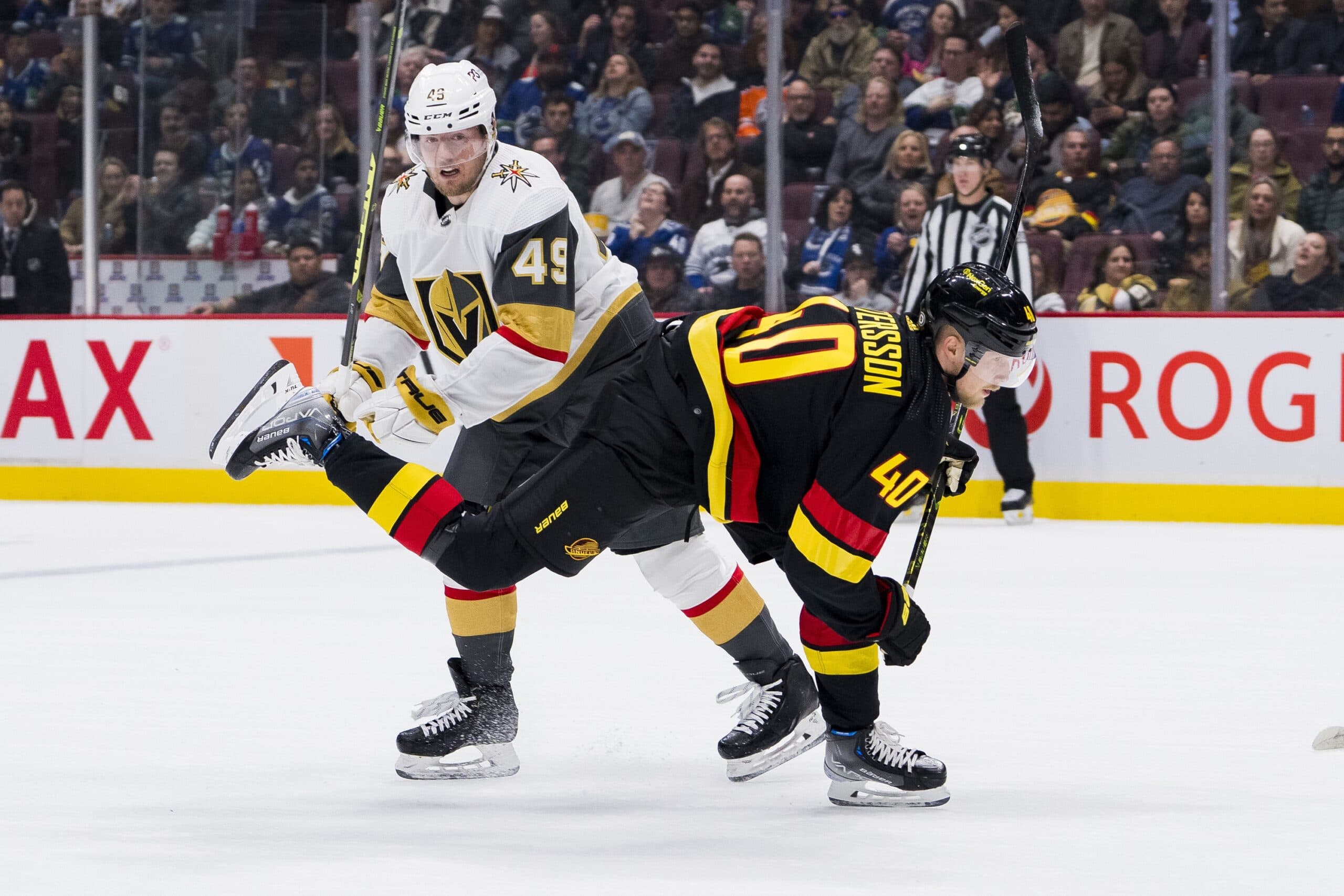Nation Sites
The Nation Network
CanucksArmy has no direct affiliation to the Vancouver Canucks, Canucks Sports & Entertainment, NHL, or NHLPA
Why Elias Pettersson is poised to take yet another step forward this upcoming season

Photo credit: © Bob Frid-USA TODAY Sports
Oct 5, 2023, 19:42 EDTUpdated: Oct 5, 2023, 19:43 EDT
Before we begin, time for a little horn-tooting, if you’ll indulge us.
Approximately one year ago, on this very website, this very same author published an article entitled “Elias Pettersson is about to take off into elite status for the Vancouver Canucks.”
We might not nailed all of our predictions here, but on this particular take, we couldn’t have been more on target.
We talked about Pettersson getting a more complete offseason in, we talked about his dreadful start to the 2021/22 campaign that turned into a red-hot finish, we talked shooting percentage, we talked the prospect of consistent linemates.
We ended with this: “Pettersson is both in his prime and primed – primed to have the best season of his career to date, and primed to be recognized as belonging to the upper echelons of NHL talent.”
Check and check.
Though, to be honest, even we didn’t see Pettersson taking quite as big a leap as he actually did.
In the 2022/23 season, Pettersson upped his previous career best in points from 68 to 102, and his previous best PPG from 0.97 to 1.28.
That’s a Neil Armstrong-sized step forward.
The recognition came with it, too. Pettersson finished 18th in voting for the Hart Trophy and fifth in voting for the season-ending First All-Star Team at the center position, easily placing himself within the echelon of top-tier pivots in the NHL. And, though it wasn’t a part of our prediction, Pettersson also progressed mightily in his own end of the ice, winding up in seventh place in Selke Trophy voting and receiving plenty of accolades as one of the greatest two-way threats in the game.
So, where does Pettersson go from here?
Well, as far as we’re concerned, it’s time to double-down. Because we’re here to predict, once again, that Pettersson is going to take a further step forward in 2023/24. That’s right, it’s a breakout on top of a breakout, and we’ve actually got a little bit of evidence to back us up.
At the age of 24, and turning 25 in November, Pettersson is still firmly ensconced within his expected prime. Estimates vary, but most tend to agree that NHL forwards typically hit their statistical peak between the ages of 23 and 28, so there’s nothing unusual about Pettersson continuing to pile more points on the board over the next couple of years.
Last year, we wrote about the stark dichotomy between Pettersson’s start and finish, with him going from a sub-PPG beginning to a 1.19 PPG run from mid-Jaunary 2022 onward.
Though it was harder to notice due to the difference not being quite so extreme, Pettersson’s 2023/24 campaign also saw a notable uptick in its back-half.
It makes sense to split the Canucks’ season right at the January 30, 2023 mark. Though that’s not quite the halfway point, it is the point at which captain Bo Horvat was traded, and also the point at which new head coach Rick Tocchet had firmly settled into the position.
Prior to that January 30 date, Pettersson played in 47 games and posted 21 goals, 37 assists, and 58 points for a PPG of 1.23. That total led the Canucks and was well over and above any rate that Pettersson had ever produced prior — but it would turn out that he still had at least one more gear.
In our writeup last year, we speculated that Pettersson would benefit from being part of the Pettersson-Miller-Horvat 1-2-3 punch at center. We reasoned that having those two other high-profile pivots centering their own two-way units would mean fewer defensive responsibilities and lesser opposing attention for Pettersson, which we thought would cause his scoring to skyrocket.
In the end, it wasn’t that much of a factor. Pettersson both took on increasing defensive duties and faced increasing attention from the opposition, and it didn’t slow him down at all. And then, with Horvat traded and all those responsibilities automatically got cranked up a notch, Pettersson responded by hitting another level.
In the end, it wasn’t that much of a factor. Pettersson both took on increasing defensive duties and faced increasing attention from the opposition, and it didn’t slow him down at all. And then, with Horvat traded and all those responsibilities automatically got cranked up a notch, Pettersson responded by hitting another level.
From January 30 onward, Pettersson played in 33 games and posted 13 goals, 26 assists, and 44 points, for a PPG of 1.33. Forget leading the Canucks, those 44 points were tied for fifth-place in the entire league across that same period.
In other words, Pettersson just kept getting better as the 2022/23 progressed, and thus there’s every reason to believe that he’ll continue to do so into 2023/24.
Including some specific reasons.
Here’s the mind-blowing fact that we’ve been waiting to drop on you all article:
Pettersson experienced the lowest shooting percentage of his career in 2023/24. That’s right. That’s not a typo. The lowest.
Now, we’re not talking an extreme dip. Pettersson had previously posted campaigns of 19.4%, 16.7%, 15.9%, and 16.7% heading into last season, establishing himself as a consistently high-percentage shooter.
In 2022/23, his final percentage was 15.2%. That’s not bad by any stretch of the imagination, but it’s a 1.5% drop from the season prior, 4.2% below his career best, and 0.7% lower than his previous career worst, which was in his difficult 2020/21 campaign.
Usually, fluctuations in shooting percentage are used to track “puck-luck” and can be seen as indications that a player is due for a rebound or a regression. The reasoning typically goes that a player shooting well above their career shooting percentage is possibly getting lucky, and will eventually regress, with the opposite being true for someone shooting well below their career average.
Prior to last season, Pettersson’s career average was at about 17%. So, he did shoot a far bit below his average, and he still posted results well over and above anything he ever had prior. Can a player truly “rebound” from a breakout season?
Not really. But they can build upon it, and that’s what Pettersson is poised to do.
It’s been another full offseason, without injury, for Pettersson. He’s once again arrived in Training Camp in excellent shape, and having spent the summer further developing his game. We’ve already shouted out his drastically-improved faceoff abilities, which had previously been held up as the great flaw in his skillset.
It’s not hard to see how that, too, can lead to more points. More faceoff wins means more possession time, and when Pettersson’s line gets possession, they tend to keep it, and as often as not, they keep it long enough to put something on the scoreboard.
That comment we made last season about consistent linemates proved to be half-true. Pettersson spent almost the entire season lined up with Andrei Kuzmenko, and the results truly speak for themselves. This year, he’s once again attached at the hip to Kuzmenko, and the two will be able to build on their pre-established chemistry from the get-go.
Really, there’s nothing standing in the way of Pettersson taking yet another step forward in production in the 2023/24 season.
What would another breakout even look like? With the 100-point barrier already broken, it’s difficult to say without sounding too optimistic. 110 points? 125? 150?!
We’re getting ahead of ourselves, no doubt. And obviously, this all comes with a “health permitting” caveat. But the possibilities are truly exhilarating, and we don’t really feel the need to calm down. Hype is fun.
Oh, and we almost forgot to mention one more key factor: it’s a contract year. It’s the season in which Pettersson hopes to put forth a case toward signing the largest contract of his professional career, the one that will set him up for life from here on out. Between that, his stated desire to see the team improve, and his own general drive toward excellence, he’s got motivation for days heading into the regular season.
Maybe there isn’t a point total that’s out of the question at this point…
Breaking News
- Quinn Hughes talks thought process in lead-up and aftermath of trade from Canucks to Wild
- Wagner’s Weekly: After Hughes trade, which Canuck will get traded next?
- The Stanchies: Zeev Buium’s two point debut leads the way in Canucks’ 2-1 victory over Devils
- Canucks forward Lukas Reichel clears waivers
- Instant Reaction: Zeev Buium scores game-winning goal in Canucks debut vs. Devils

